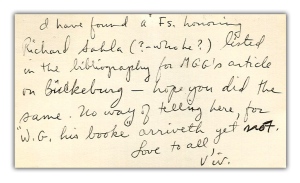
The practice of using music incipits for identifying compositions occupies an important place among the many musicological research tools that Barry S. Brook conceived. “The thematic index derives its superiority over non-thematic lists because it can not only arrange a body of music in a systematic order,” he wrote, “but it provides, at the same time, positive identification in a minimum of space and symbols. It does so by the use of the incipit, or musical citation of the opening notes. For most music, an incipit of no more than a dozen pitches is required. When rhythmic values accompany the pitches, the incipit’s uniqueness quotient is astonishingly high” (Notes, 29/3, 1973).
He promoted this idea through the publication of facsimile editions of The Breitkopf thematic calagoue (1967) and The Ringmacher catalogue (1773; 1987); he organized the index to his edition The symphony, 1720–1840 (1986) in the form of a thematic catalogue; and he published the definitive catalogue of thematic catalogues (1973; 2nd ed. 1997). In 1970 he made a proposal for his Plaine and Easie Code, a computer-readable coding system for music incipits in modern or mensural notation, and when RISM initiated the cataloguing of manuscripts in the A/II series he was a strong advocate for the inclusion of the incipit in the bibliographic description of each work.
Brook’s enthusiasm for incipits was sparked when he was writing his dissertation in Paris. His daily correspondence of 1958/59 with his wife Claire—whom he married only a few months before the trip to France—was full of notated incipits for works that he mentioned in his work, La symphonie française dans la seconde moitié du XVIIIe siècle, and she patiently copied them and organized them in the thematic finder to be included with the final dissertation. His system of organizing incipits was a response to the index of eighteenth-century compositions that Jan LaRue was working on at the time, and the Dictionary of musical themes by Sam Morgenstern and Harold Barlow, both of which he found unsatisfactory.
In February of 1959 he told Claire in a letter about his thoughts for organizing the index:
“I think it will be number of #’s + ♭’s, with minor in with the majors since in some instances it is not immediately apparent from incipit if it is in minor; then subdivided into 2/4, 3/4, 4/4, 3+6/8; then in alphabetical order note by note. If you run into LaRue you might ask him to explain his system—or even better ask him how he would do it if he were to start all over again….Then there is that crazy suggestion of Chailley, which he put very strongly, to transpose all themes into C and list them by letters alphabetically. — Take a look at appendix of Morgenstern-Barlow Dictionary of musical themes that we have and you’ll see what he wants. This looks like another big job for you. e.g. EFGGGGGGGGABGBA = Gossec #1 GCCDGDDEGEEF = Gossec #2 CDCGCDE♭F = Gossec #3” (15 February 1959).
A week later Barry returned to the topic and again asked Claire to have a talk with LaRue about how his finding system works, and whether or not he counted grace notes in alphabetizing. As LaRue was at the time still collecting incipits for his thematic identifier, he warned Claire not to reveal all that he was doing: “A little birdie keeps tweeting me about what Chailley said about keeping everything (i.e. finds) under wraps until after the thèse” (21 February 1959).
As Barry studied scores in Parisian libraries, he found more works that needed to be included in the finding aid for his thèse, and more incipits were included in his trans-Atlantic letters to Claire. Almost every letter he sent her in the late winter and spring of 1959 included a few handwritten incipits, a new consideration about their ordering, or a question about this or that detail.

Replies from Claire included “just finished cutting a complete set of corrected insipids [sic], wrapped, stored, and next set ready to go” (19 April 1959), and “I refused to allow myself to sit down and write to you until the thematic index was cut and packed for mailing. A sort of external discipline—childish but effective. Just finished tying the string and lettering in the beloved name of my husband, and here I am” (27 March 1959). It seems that Claire worked on his dissertation in New York as hard as Barry did in Paris! It is impressive to see how they worked together on the intricate project of organizing the musical index of incipits, without having instant messaging, a possibility of online conversations in real time, and any other benefit of communications that we take for granted today.
At one point he was frustrated with difficulties in sorting incipits, and described to Claire his idea about an incipit box. Claire was confused by his eccentric idea and asked him to describe his concept better. In his second attempt he drew the design of the box along with his explanation of the concept: “Incipits are arranged in order in the box like file cards in a filing box or fiches in a fichier. Only the box is very flat—just high enough for the incipits to stand up in” (24 March 1959). As the deadline for submitting the dissertation was approaching fast, there was no time for constructing the box.

On 29 June the thesis—which included some 60 pages of incipits in addition to some 800 items that converted incipits to alphanumeric strings—was “delivered to [Jacques] Chailley at 5:30 in the afternoon”. This might have been one of the earliest dissertations that included such an extensive catalogue of incipits. A week after it was delivered, Claire landed in Paris for their belated honeymoon.
Above, one of Barry and Claire Brook’s wedding photographs from June 1958.
















